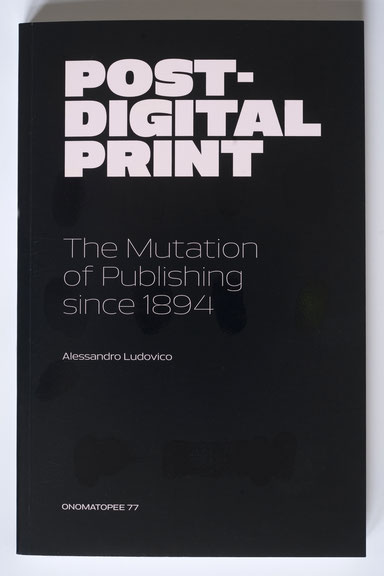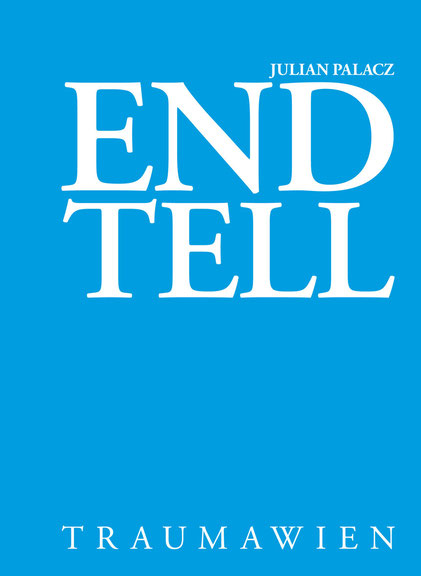Dust: on top of books that no-one has leafed through for some time – dust which, depending how long the volume has been sitting on the shelf, can be removed from the bound paper by blowing hard. Dust again: on the blades of the ventilator within the computer, keeping the operating temperature in check – dust that settles on the hardware and creeps into the spaces between plastic and metal. »Dust« is listed as point 91 of »100 differences and similarities between paper and pixels«, which appears as an annex to the recently published book »Post-Digital Print – The Mutation of Publishing since 1894«1.
The author, Alessandro Ludovico, begins his historic overview of activist media technologies and avant-garde publishing methods with the succinct statement: »We’ve all heard the news: print is dead«. In the roughly 200 pages that follow, his approach is not limited to merely presenting the various points at which print has been declared officially dead in the face of technological utopias, starting from the publication of Octave Uzanne and Albert Robida’s “La fin des livres” in 1894. Above all he addresses the question of how long it will be possible to maintain the dichotomy between the haptics of paper and the changeability of the pixel, and how long it will be before these two poles move closer together and begin to merge in our post-digital era.
Despite the insight formulated by Marshall McLuhan in the early 1960s, which has become a cliché – if not a platitude – over the last few decades, namely that no newly emerging medium can displace an old medium, but is certainly capable of supplementing it, there are certainly good grounds for the questions raised with »Post-Digital Print« in the discussion currently underway on digital books, exploitation rights, plagiarism and authorship. According to the chapter »The death of paper (which never happened)«, we are now once again (or rather: still) in an era – long after the advent of telegraphy in the second half of the 19th century, and later of radio, television, the computer and finally hypertext – in which the book is once again (or is still) proclaimed dead. The angle from which Ludovico sheds light on this topic with historic facts relativises the sometimes highly emotional and heated discussion conducted in the mainstream media, which offers little scope for a nuanced approach somewhere between the extremes of completely abandoning the logic informing existing rights exploitation and clinging uncompromisingly to this logic.
The author identifies the future of post-digital printed works, with the virtual realm coupled with the analogue realm to form a new hybrid, as lying, for example, in distribution channels that are organised as networks and provide publications in real time, just as he portrays »on-demand« options and customer-oriented adaptations of printed information, individual book-printing devices and experimentation with the newest technologies as a part of a realistic scenario as the medium of the book is extended. He cites QR codes as an example of a digital technology that has potential for utilisation in the world of conventional printing. These are the black and white cube patterns, now widespread in everyday life, that can be scanned and read with smart phones and other mobile devices, and connect up to the information enshrined in the code. As Ludovico proposes, the rigid contents of printed products could be constantly updated by using this kind of code, and thus be maintained in the information flow.
Even if »Post-Digital Print« tends to ascribe the McLuhanian potential for media-extension to the old technology of book printing, interactions with the new technologies of digital publication are repeatedly underscored. This is because of a shortfall diagnosed in the world of printing, in that its products »do not incorporate mechanisms that are capable of initiating social or media processes which in turn could move the printed contents to another (processual) level«. It is only by mixing the two media manifestations, old and new, static and variable, and »without the burden of ideological affiliation to one of the two sides« that hybrid products can emerge in which the best aspects of the printed and digital interface play a part.
An exemplary project in which paper and pixel combine to form a new whole is the more than 700-page novel »End Tell«2, in which Vienna-based artist Julian Palacz kept a record of all the keyboard strokes on his computer for over a year and a half. Using a keylogger, a piece of software that reads and records in various symbols all keyboard input – all e-mails, notes, copying and pasting, all printing, and all deletions – a documentary and performative text hybrid came into being in »End Tell«, which the artist has described as a »neuroprint of the coupling of computers and humans«.
»End Tell« is the first book from publishing house TraumaWien3, founded in 2010 by an artists’ group around Luc Gross. Through experimental publications that make full use of the possibilities of the digital book in a plethora of different ways, TraumaWien has set itself the goal of perceiving »the Internet with its entire semiotic nature as literature« and experimenting with new forms of storytelling in an era in which the Net has become part of everyday life. One striking aspect of the publisher’s self-image is that its portfolio, set at the interface between analogue and digital, with products such as »networked texts, algorithmic texts, interfictions, chatlogs, codeworks, software art and visual mashup prose«, remains committed to the cultural significance of words printed on paper, although this goes against the grain of broader contemporary trends: »Transposition to the old medium of the book [...] does not only help to sharpen the gaze on technical innovations but accords key issues of virtual space a degree of importance that would otherwise be impossible to achieve«, the publishing house team write on their website.
In the light of the historic dimension, also examined in detail in »Post-Digital Print« with reference to the world of alternative publishing, activities such as those of TraumaWien fit into the genealogy of 20th-century autonomously organised avant-garde printed work. Starting with Italian Futurism around Filippo Tommaso Marinetti and his penchant for magazines and the Dadaists, continuing through to the Surrealists and the Fluxus movement founded in the 1960s by George Maciunas, and encompassing the widespread zines and flyers of the punk movement, the printed work expresses a political stance, not just in terms of its substance but on a formal level too. »Even if it calls the printed medium into question,« to cite Ludovico’s summary about magazines, all printed works have, in a self-referential and material-related fashion »reflected on precisely this medium […] just as they have called into question the historic time period of change that they were part of.« It is not clear how this change will be manifested nowadays and in the coming years, what kind of hybrid forms it may engender in an age in which digital technologies are already omnipresent and are becoming increasingly self-evident. The outcome in the game of »hybrid, screen, paper« that is currently being played on every corner remains just as uncertain. There is only one component in this game that will remain absolutely certain: dust.
Translated by Helen Ferguson
1 Alessandro Ludovico, Post-Digital Print, The Mutation of Publishing since 1894, Hogeschool Rotterdam & Onomatopee. Eindhoven 2012; http://monoskop.org/log/?p=4165.
2 Julian Palacz, END TELL, TraumaWien. Wien 2010; http://palacz.at.
3 TraumaWien; http://traumawien.at.

